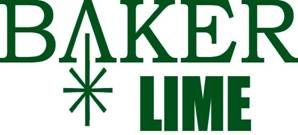Lawn Care for Cool-Season Lawns
Table of Contents
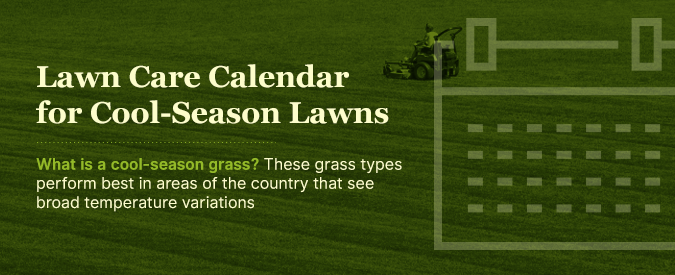
Author/Reviewed By: Josh Miller, Sales Manager: Baker Lime & North America Minerals
Published: 6/20/2018 – Updated: 8/2/2024
Your local climate plays a huge role in determining the best type of grass to use on your lawn. If you live in the upper two-thirds of the United States, it’s likely your lawn is composed of cool summer grasses. These states include Connecticut, Ohio, New York, Idaho, Delaware, Massachusetts, Iowa, Maryland, Pennsylvania, Maine, Michigan, Rhode Island, Minnesota, South Dakota, Montana, Utah, Nebraska, Vermont, Virginia, New Hampshire, Wisconsin, New Jersey, Washington and Wyoming.
What is a cool-season grass? These grass types perform best in areas of the country that see broad temperature variations: hot summers and cold winters – like the northeast. They grow best in the spring and fall when temperatures are between 60 and 75 degrees Fahrenheit. A cool-season grasses list includes Kentucky bluegrass, annual ryegrass, perennial ryegrass, fine fescue and tall fescue.
The key to keeping your yard looking great during the growing seasons of spring, summer and fall is regular maintenance. Here are some factors that contribute to having a lush, green lawn you and your family can enjoy:
- Knowing what time of year does grass start growing
- Knowing the best time of the year to apply fertilizers and weed killers
- Mowing the grass to the proper height, so it creates optimal growing conditions
- How often you should water your lawn depending on the temperature and weather
- Knowing when to aerate cool season grass or dethatch your lawn
Common Types of Cool-Season Grasses
Interested in knowing what type of grass grows in Pennsylvania and the northeast? Here’s a guide to cool season grasses identification.
Kentucky Bluegrass
Kentucky bluegrass grows with a lovely true green color, but it can turn brown during hot weather. It has narrow, fine leaves. If you want a fine-textured, deep green and beautiful lawn, Kentucky bluegrass is the right choice.
- This type of grass has a medium tolerance for cold and heat and is a winter-hardy grass.
- Bluegrass has a medium tolerance under stress conditions like foot traffic but can perform well in high-traffic areas of your lawn.
- Too much shade is not ideal for bluegrass. It works well in areas that have moderate shade and performs best in sunny areas.
- As noted above, it can go dormant and lose color during a hot, dry summer.
Perennial Ryegrass
This ryegrass is a non-spreading variety that germinates quickly from seed. It grows at first with a bright green color that darkens over time. A fine-bladed grass, perennial ryegrass’ distinguishing feature is the whitish cast you’ll see on the top of grass blades after mowing. It grows well in a wide range of soils, including those that are wet.
- Perennial ryegrass does not have a good tolerance for drought or cold. It performs best in coastal areas that have mild winters and cooler, moister summers.
- It has a very high tolerance for stress and performs well in areas of your yard that have a lot of traffic.
- Like Kentucky bluegrass, it only has a low to medium tolerance for shade.
Fine Fescues
These grasses — which include creeping red fescue, chewing fescue, sheep fescue and hard fescue — are fine-textured, upright, dense and good-looking leaves. The leaves have a gray-green color. They do not need much fertilizer, which makes them ideal for low-maintenance lawns. When added to other grasses, fescues increase resistance to disease and pests.
- Fine fescues do not perform well in heat, although they have a good tolerance for colder temperatures.
- If you know your lawn will receive a lot of foot traffic, do not seed it with fine fescues, as they are not the best choice for high-traffic areas.
- Fescue is the best cool summer grass to use if your lawn is very shady.
Tall Fescues
Tall fescues, another bunching-type grass, reliably produce a dark green color even if you live in a location with prolonged summer heat, thanks to its deep root system that helps it tolerate drought and warm weather. It features big-bladed leaves and bunching characteristics that give it a rougher look than the finer bluegrass or perennial ryegrass.
- That deep root system makes it an ideal grass for areas of the country that can have temperature swings from deep cold winters to quite hot summers.
- Tall fescues have a reasonably good tolerance to stress and are an ideal choice for playgrounds which require a hearty utility grass.
- It performs reasonably well in shaded areas but is an excellent choice for sunny lawns. With too much shade, it will thin out and clump.
Infographic – Cool Season Lawn Care Calendar
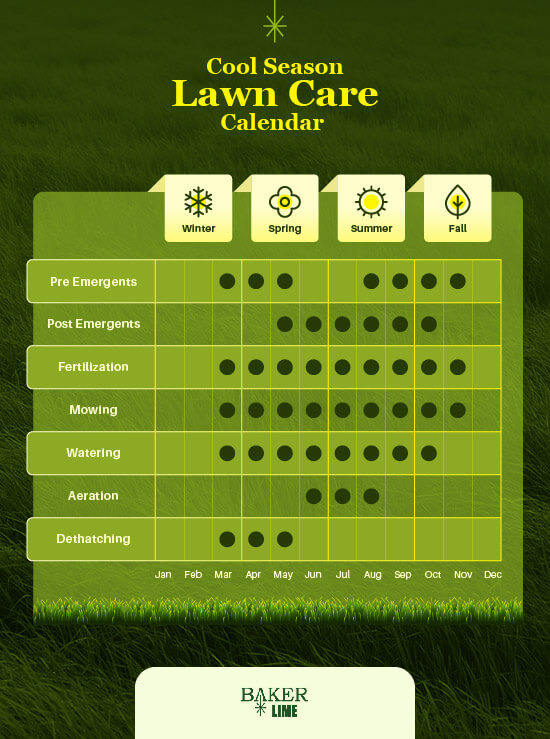
Seasonal Lawn Care Schedule for the Northeast:
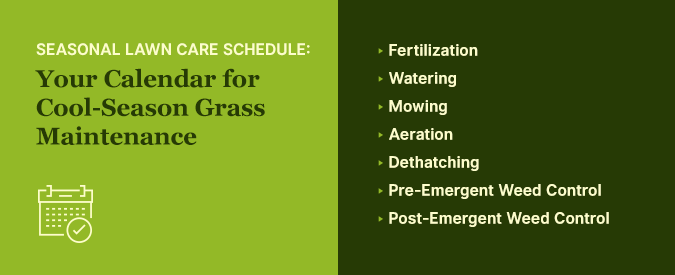
Here is a more seasonal do-it-yourself cool season lawn care schedule for the northeast and states like Maryland, Pennsylvania and Delaware.
1. Lawn Fertilizer Schedule
“When should I fertilize a cool-season lawn?” is a common question, but the fertilization of cool-season grasses doesn’t have to be complicated. You should fertilize two to four times per year, based on soil testing. The best months are March or May and September or November.
Fertilizing your lawn is key to making sure it has the nutrients it needs to prosper and thrive. That is why it’s important to use a soil analysis kit. Finding that balance between too much and too little fertilization takes some thought. When thinking about a fertilization schedule for cool season grasses don’t be afraid to fertilize your lawn as many as four times a year, including late and early spring, once in the summer and once in the fall. These treatments will help your lawn be both healthy and resilient.
Pro tip: When you fertilize in the spring, you can use a “weed-and-feed” fertilizer that contains both a fertilizer and a pre-emergent.
2. Watering
From June until September, you should water your lawn weekly when rain levels are below one inch. That, of course, depends on where you live and the specific type of grass you’re using. You water your lawn to help it retain its color. When you water your lawn infrequently but deeply, it encourages roots to grow deep. However, if you water your lawn frequently and use water sparingly, the opposite effect occurs.
If it rains more than one inch a week during any week, you do not need to water your lawn.
Remember, water in the morning so you won’t scorch the grass. Another reason to water in the morning is that the grass will be dry by the time afternoon or evening humidity sets in.
3. Mowing
Mowing plays a more important role in the health of your lawn than you might first expect. If you cut the grass too closely, it makes your grass more susceptible to disease, and you’ll find yourself doing more to keep it in good shape.
During spring, mow your grass as often as once per week. During summer, mow once every two weeks. When the temperatures start to fall in autumn, you’ll need to mow your grass once a week again until it advances into a dormant stage. Usually, this happens when the temperature drops to 50 to 55 degrees Fahrenheit for a week.
A good rule of thumb for mowing is never to remove more than one-third of the length at one time. Most cool summer grasses like it best when they are between two to three inches long.
4. Aeration
Aerate your lawn one to two times a year, once in March or April and again in September or November. Compacted soil reduces growth because it’s difficult for air, nutrients and water to reach roots. That can also lead to pest problems and make it harder for grass to recover from damage.
Core aeration is your best bet. Large hardware stores will rent variation machines for larger lawns, and you can use a hand corer for small areas. Leave the cores of earth on your lawn, because they add nutrients. New grass will fill in the holes you create by aeration.
5. Dethatching
Dethatch your lawn once a year, in either March or April. Recognizing thatch is easy. Grass grows excessively before it can decompose. Like compacted soil, thatch acts as a barrier to air, water and nutrients. Thatch will also harbor bacteria, insects and fungus.
Use a rake to dethatch your lawn, or try a verticutting machine on patches of excessive thatch.
6. Pre-Emergent Weed Control
You’ll want to use pre-emergent weed controllers twice a year — once in March and once in May. These products kill weeds below the surface. Apply them just before the soil reaches 55 degrees Fahrenheit and weed seeds begin to germinate. Timing is crucial in applying pre-emergent weed killers. And pay close attention to mowing instructions on the product label. Mowing at the wrong time will reduce its efficiency.
7. Post-Emergent Weed Control
Apply post-emergents once or twice during the growing season, in June and then again in November if necessary.
Post-emergents attack already grown weeds. Choose a pre-emergent carefully. Some of them will only kill targeted weeds, while others will destroy anything they come in contact with, including grasses. Again, check the label for mowing instructions.
Why Is Year-Round Lawn Care Important for Cool-Season Grasses?
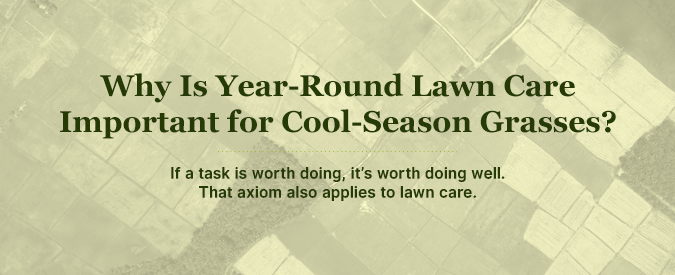
If a task is worth doing, it’s worth doing well. That axiom also applies to lawn care. If you want a beautiful, green lawn that’s the envy of your family and neighbors, it requires a little elbow grease. Cool summer grasses can look beautiful when properly maintained.
If you stick to the monthly and seasonal schedules we’ve outlined above, you’ll be well on your way to achieving your dream lawn. The schedule will also help reduce your stress about creating and maintaining that lawn. Too many people try to do all the steps at once and end up frustrated and with a less-than-healthy-looking lawn.
Don’t try to do it all at once. Stick to the lawn maintenance schedule.
Let Baker Lime Help You Restore the pH Balance to Your Cool Summer Grasses

If you’re concerned about the color of your grass and it’s not quite as thick you would like, limestone may be the answer you’ve been looking for. When you apply limestone, you increase bacterial activity, which helps create a better soil structure. Lime helps disintegrate organic matter in compost, which makes the soil more porous. That gives the air a better chance to circulate through the soil, which in turn helps with water absorption. The roots of your grass will grow stronger and be more efficient when it comes to collecting nutrients.
We’re happy to help with cool summer grass lawns in Pennsylvania, New York, Maryland, Delaware, Ohio and New Jersey. Our knowledgeable and expert staff are happy to answer your questions about our high-quality products. They can help you determine the best time to use lime on your lawn and how much you should use depending on the type of your lawn’s cool summer grass. Find and contact your local Baker Lime dealer today!
